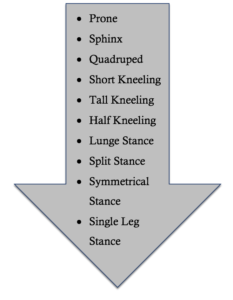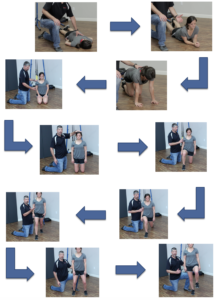by Mitch Hauschildt, MA, ATC, CSCS
There are a number of ways that we can progress people from simple to more complex exercises and programs. One of the easiest and most successful progression models is to move people through different postural positions. By making small changes to posture, the nervous system is challenged in new ways. When you utilize the same movement but with different positions, the brain will recognize each movement as a new or different exercise. This opens up an endless exercise library with just a few simple exercises.
For example, if you are performing a kettlebell halo, performing it in tall kneeling, half kneeling or single leg stance essentially gives you 3 different exercises in the mind’s eye, but keeps your teaching and programming very simple. This approach allows you to progress people simply and easily and keeps your patients from getting stagnant. It also sets your patient or client up for success.
Too many times we try to progress people through very complex movements and the learning curve is huge and it wears both you and the people performing the movements out mentally. Progressing people posturally helps you layer on top of an easy movement and position quickly and efficiently. If they understand the coaching points of the halo (to use the example from above), they will know the same coaching points, regardless of the postural position. Now you can focus on the finer points of the movement and posture. This approach sets your patient or client up for success and it minimizes your coaching, so it is a win-win.
This approach is the foundation of my home exercise programs. It allows me to teach a movement once and then adjust and modify things remotely without seeing the client (when appropriate).
Below is a simple progression to work through, ranging from simple to complex (for the most part). This progressing largely works from the bottom up and progresses from simple to complex. I do acknowledge that a position such as a lunge stance is more demanding than a symmetrical stance for a lot of people. This is where the aunt of coaching comes in. Try different progressions and know your client. The goal is to always make exercises challenging but achievable. If they can’t control it, motor learning won’t take place. Control is the key to these progressions.
The progression, moving from simple to complex, looks like this:
- Prone
- Sphinx
- Quadruped
- Short Kneeling
- Tall Kneeling
- Half Kneeling
- Lunge Stance
- Split Stance
- Symmetrical Stance
- Single Leg Stance
Work through this basic sequence with just about any exercise and you will see good results.



Leave a Reply